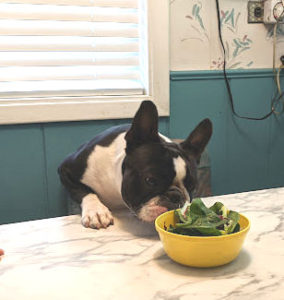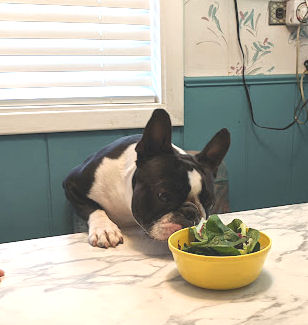When cute little puppies grow tall enough, or clever enough, they discover the joys of counter surfing. Since dogs reliably choose to do what’s most rewarding for them, if they find anything on that counter, they’ll do it again. And again. As long as there are treasures to find, the dog will keep finding them. We imagine there are quite a few family holiday stories that feature a naughty dog stealing some of the featured feast off the table or counter. It may be funny and fondly remembered over the years. But it’s not fun at the time. Not to mention panic-inducing, if it was the centerpiece turkey that’s gone down the dog. Stop your dog counter surfing forever.
Nip it in the bud
Ideally there will be absolutely nothing on the counter the dog finds attractive. If they try counter surfing and get nothing, they have no reason to try again.
Don’t assume that because your dog can’t reach the counter they can’t steal stuff from it. The memory of Hope’s French Bulldog Teddy up on the kitchen counter is burned into our memories. He stood 12 inches tall. The standard counter height is 36 inches. Did he jump? No. He got onto the kitchen chair. Climbed from there onto the table, and then across to the counter. He only did it once (that we know of), but it’s legendary in the family.

Realistically, few of us can completely clear counters, table tops, and other flat, reachable surfaces. Even in the throes of training a new dog, you still have to live your life. Until your dog gets the message, if you can’t completely contain the stuff, contain the dog.
If the counter-surfing canine only has access to the attractive surfaces when you’re there, you can use every interaction as a training opportunity.
Send the message
To counter counter-surfing, set up the scenario. Have a dog bed nearby. Stand at your regular cooking position and start cutting up a carrot. Or celery. Something your dog likes and is allowed to have. If your dog intrudes by sticking their nose under your arm, putting their front paws on the counter, or trying to get at the carrot, stop what you’re doing and cover up the “work” with your arms and upper body. If you have to lie on it, do so. Don’t say anything to the dog. Just stare at the dog bed.
If you tell your dog “Off!” or “No!” or even “Uh-oh” you’re still telling them what to do. The objective is to have the dog make good decisions even if you’re not there to tell them. If you always tell your dog what to do, you’ll always have to. Over the course of your dog’s lifetime, that would be exhausting.
If you put in the effort to teach them good decision-making now, over the course of years you’ll both be much happier.
Stand firm
At first, with the carrot and counter covered, your dog won’t understand what’s going on. They may paw at you, try to burrow under your arm, or even start whining. This is the part where you must be patient. Waiting is the absolute hardest part of dog training. Don’t say anything. Don’t move. Just stare at the dog bed.
As soon as your dog has all four feet on the floor, or looks at the bed, toss a piece of carrot into the bed. As long as the dog is behaving, keep tossing pieces of carrot in the bed. Just by your actions, you’re teaching the dog that their place in that bed is highly rewarding.
If they get the carrot piece and then come bounding back to jump some more, cover up and repeat. Single-minded dogs may take a few sessions to get the idea. But they will get it.
Stop your dog counter surfing forever
Eventually, if you’re patient and consistent, you’ll have a terrific companion for your kitchen endeavors. You can even look forward to spending some companionable time together. If you want to give your dog a chew toy on the bed while you’re preparing food, by all means go ahead.
Throughout your dog’s life, even when they know the house rules, make a point of rewarding them for good decision-making. If you see your dog glance at the counter and then walk away, reward it. That’s a sure sign that the training has worked and your dog really does know better.

